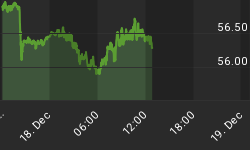Strong Economy or High Inflation?
The purpose of Fed money printing is to help support economic growth and job creation. The negative side effects can be rising inflation or asset bubbles. Therefore, from a logical perspective, the Fed would be interested in tapering if: (1) the economy is strong enough to stand on its own, (2) inflation is getting uncomfortably high, or (3) they were growing concerned about asset bubbles.

Economy Is Doing Okay
The economy has improved since the financial crisis. However, economic growth is far from robust.

The next GDP announcement comes Wednesday at 8:30 a.m. EDT. According to the New York Times, the news may align with the muddle-through theory of economic growth:
New data from the government due out Wednesday is expected to show that the economy came close to stalling during the spring quarter, which ran from April through June. "We've been saying for some time that second-quarter growth would be the weak spot this year," said Nariman Behravesh, chief economist at IHS. "This is the spring swoon. But I wouldn't panic -- there is a very specific reason for it, and it will start to wear off."
It is doubtful confidence in the economy would be the primary driver behind tapering discussions at the Fed.
Are Jobs Being Created Fast Enough?
As we outlined on July 19, one of the objectives of a bond-buying campaign (a.k.a. QE) is to assist the Fed in meeting their mandate of maximum employment.

How close is the Fed to meeting their employment objectives? Not all that close. Ben Bernanke reiterated earlier this month that, "There will not be an automatic increase in interest rates when unemployment hits 6.5 percent." Where is the unemployment rate now? On July 5, it was reported as 7.6%, or well above the minimum threshold of improvement noted by the Fed. An update on the employment situation is coming Friday at 8:30 a.m. EDT.

Concerns About Deflation Remain
Deflationary spirals are very difficult to contain and reverse (see Japan). Therefore, the Fed does not want a zero inflation environment. The Fed would prefer to see inflation in the neighborhood of 2%. In a July 30 article, Bloomberg reported inflation has been low for some time:
Companies lacking pricing power have helped hold the inflation rate below the Federal Reserve's 2 percent target for 14 straight months. Chairman Ben S. Bernanke and his colleagues on the Federal Open Market Committee, who meet today and tomorrow, are keeping an eye on receding inflationary pressures as they consider when to start scaling back $85 billion in monthly asset purchases aimed at strengthening economic growth. Bernanke has said low inflation could cause the recovery to bog down by inhibiting capital investment and increasing the risk of "outright deflation," a broad-based decline in prices. "Very low inflation poses risks to economic performance," he told lawmakers July 17. "We will monitor this situation closely."
As shown in the chart from the Federal Reserve Bank of Chicago below, inflation is expected to remain below 2% for some time, which means it is unlikely the tapering dialogue at the Fed was sparked by serious concerns about inflation.

Why Talk Taper?
If the economy could be in another "soft patch", and inflation is not a problem, then that leaves asset bubbles as a possible driver for tapering. When the Fed ramped up their tapering talk in late May, the S&P 500 was in a near vertical ascent.

It seems fairly logical the tapering dialogue at the Fed is more about escalating fears of another round of asset bubbles rather than confidence in the economy or fears about escalating inflation. Therefore, the Fed may still announce some tapering at their September meeting. However, any tapering statement will most likely be accompanied by a pledge to support the economy with low rates for an extended period.

Fed Should Continue To Support Stocks
The fear of tapering has helped the Fed slow the pace of the stock market's ascent, which means Bernanke & Company have already accomplished something on the bubble front. It is unlikely the Fed is ready to do much more at this time, which means stocks will most likely continue to have the wind at their back in the coming months.
Investment Implications
It feels like the stock market bears have made great progress in recent weeks. In reality, they have made very little. During trading on Tuesday, the S&P 500 was only six points below its all time closing high on July 22. While there is no question short-term momentum in stocks has slowed, the damage to the intermediate-term picture remains minimal thus far. As long as that is the case, we will continue to favor stocks (SPY) over bonds (TLT). We will also hold our positions in leading sectors such as financials (XLF), technology (QQQ), and small caps (IWM). If the Fed or economic data spooks the markets, we are happy to migrate toward a more conservative stance.















